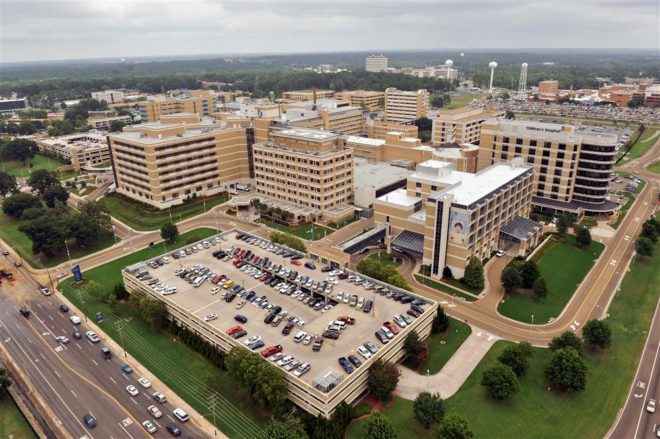JACKSON, Miss. – The University of Mississippi Medical Center received 316 extramural grants and awards in fiscal year 2017, the most in the institution’s history for a single year.
The dollar amount for this record year – $65,454,262 – is the fourth highest in Medical Center history.
“Research funding is important as we move forward,” said Dr. Richard Summers, associate vice chancellor for research. “Research techniques are becoming more complicated and expensive. At UMMC, we have been able to accomplish a lot with a little, but it will become harder to do that with time.”
Summers said two of the three years with higher funding totals, 2011 and 2012, occurred during a government stimulus period. 2014, which holds the record with more than $82 million, included funds for the new School of Medicine building.
Money from grants, awards and contracts pays for physical resources, such as equipment and supplies, and human capital, such as salary support and workforce development. While a portion goes toward community and improvement initiatives, most support UMMC’s research enterprise.
UMMC received major program grants this year, funding the new Mississippi Center for Clinical and Translational Research and Mississippi Center for Perinatal Research. The Medical Center also had renewed support for the Atherosclerosis Risk in Communities Study and the Jackson Heart Study.
“However, the fact that there were more grants awarded this current year means that more individual principal investigators with unique projects are being funded,” Summers said.
Dr. Jan Michael Williams, associate professor of pharmacology and toxicology, is one of many investigators who received a grant from the National Institutes of Health.
“This award helps build the laboratory and provide infrastructure,” Williams said. It also facilitates travel to scientific conferences, key to finding collaborators, who “help build research capacity and establish new projects.”
Williams studies the role of obesity and diabetes in kidney disease. He’s using a model that develops obesity and hypertension early in life to study the causes of kidney injury associated with childhood obesity.
With one in three American children overweight or obese, “Physicians are seeing more and more children with signs of kidney disease. Childhood obesity is increasing to the point where physicians are starting to check kids for proteinuria [a marker for renal disease],” Williams said.
“Most people with obesity have elevated glomerular filtration rates,” he said. In other words, the kidney increases the rate it filters blood. In his study, he expects to see the elevated rate strain the kidneys, which could lead to renal disease.
Dr. Bernadette Grayson, assistant professor of neurobiology and anatomical sciences, received a grant from the Department of Defense to study how spinal cord injuries, or SCI, alter metabolism.
“When controlled for inactivity, these individuals have higher levels of hypertension, lipidemia and obesity than people with other types of injuries,” Grayson said. “It’s likely a component of the central nervous system with a genesis in the injury.”
Her hypothesis is that inflammation caused by SCI affects the brain cells and hormones that regulate body weight control. By comparing low and high-fat diets, Grayson expects to see changes in how much the subjects eat and how their bodies control glucose.
“The strength of this study is that it incorporates two areas of research that have never really been put together,” she said. “Understanding if there is anything unique about the way SCI individuals gain weight and control glucose will help clinicians direct the trajectory of their care long term.”
UMMC has a strong track record of using research funding well. In 2016, Dr. Wayne Wahls of the University of Arkansas for Medical Sciences penned the essay “Send my tax dollars to Mississippi,” which highlighted UMMC’s efficiency in turning NIH funding into results.
“Taxpayers net more scientific publications by funding investigators at the University of Mississippi Medical Center…than by giving the funds to prestigious and top-ranked institutions,” Wahls wrote. UMMC researchers published 10 peer-reviewed articles per $1 million of NIH funding; Harvard and Johns Hopkins University averaged about five.
Most of UMMC’s funding comes from the NIH and other federal agencies. However, other groups support basic and clinical research.
Summers wants UMMC to double its research funding in the next five years. He said this is attainable if the Medical Center thinks outside the box.
“We need to look for opportunities outside of our traditional sponsors, including industry and foundations,” Summers said. “All money is green.”
He points to UMMC’s recent infrastructure investments as incentive to fund research here, like the soon-opening Translational Research Center and plans for a Clinical Trials Unit.
“The work we’ve done over the last couple of years, capitalizing on support we’ve received from the state and federal governments for research facilities, have positioned us for success in the future,” he said.
RELATED: Open house at UMMC will showcase new medical school




